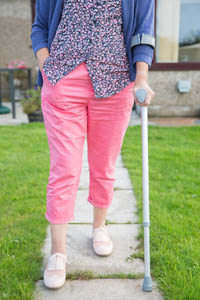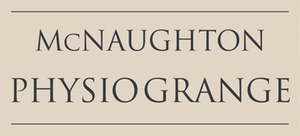Help – I’m Hirpling!
Nothing, it is said, rhymes with the word “purple” but any Scottish Physiotherapist will tell you that this is wrong. “Hirple” rhymes beautifully, and is used to describe limping or hobbling. We often hear patients complain that they are hirpling because of their hip pain, as they ask us what is wrong.
One common cause of hip pain has the wonderful name of Greater Trochanteric Pain Syndrome or GTPS for short. This is the name given to pain at the lateral side of the hip.  Symptoms can include pain on walking which is worse going up or down stairs, pain on prolonged standing, pain when lying on your side which can disturb sleep at night, and localised pain at the side of your hip to touch.
Symptoms can include pain on walking which is worse going up or down stairs, pain on prolonged standing, pain when lying on your side which can disturb sleep at night, and localised pain at the side of your hip to touch.
This pain is most often due to gluteal tendinopathy where the tough fibres that connect your buttock muscles to your hip bone have become irritated by repetitive overloading. It is not an inflammatory process but a degenerative one where the collagen fibres in the tendon become stressed, sustaining small micro-tears. In addition to the tendon problem, the bursa (a fluid and fat filled sack which helps to prevent friction between the hip muscles, tendons and bone) may become inflamed.
GTPS can affect between 10 – 35% of the population at some time but is far more common in women, particularly in the 40 – 60 age group. GTPS is also a problem for runners especially if they have been running on a camber or if they have suddenly increased training distance or hill running.
There is a strong association between GTPS and other conditions such as low back stiffness or hip arthritis as reduced movement in these joints affects the overall mechanics at the pelvis and hip. Local muscles can become tight or weak contributing to the development of GTPS.
Physiotherapy can do a lot to help this condition. In the early stages, advice on the use of ice for symptom control and modification of activities to prevent further overload of the tendon can help. Local manual therapy combined with exercises to improve joint flexibility can be very useful but care must be taken as some stretches, particularly for the ilio-tibial band, can sometimes make symptoms worse as they increase compressive forces over the tendon and bursa. The main way of encouraging recovery for this condition is a progressive strengthening programme concentrating on eccentric exercises for the buttock muscles. We are here to help so there is no need to put up with pain and certainly no need to Hirple!
© Physiogrange Ltd 2019

